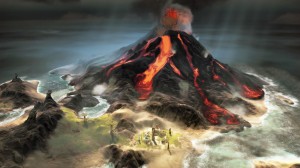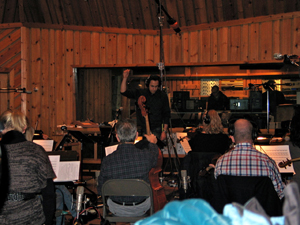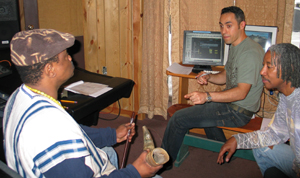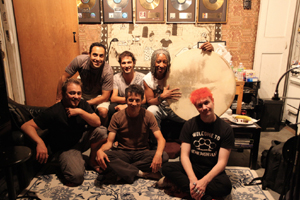Game Scoring: Pure Rhythm Drives “From Dust”
NORWALK, CT: Among the flavors of the Nutmeg State, deep tribal rhythms are not necessarily what this sleepy Northeast enclave is known for. But as you soar through the clouds and into the sanctum of Tom Salta’s studio, the pulse of advanced, yet ancient, beats beat louder.
Here Salta – one of the Northeast’s most in-demand video game/multimedia composers — is perfecting the stems for From Dust, the richly beguiling god game from Ubisoft. Created by one of the industry’s most revered developers in Eric Chahi, Salta’s skill at sculpting immersive sonic environments earned him spot on Chahi’s hand-picked team.
In From Dust, the player gets to be a god, but one with limitations: as you labor to help tribespeople rebuild their civilization and culture, you have less than total control over the tsunamis, volcanos, and fires that constantly threaten to consume them anew. In a fantasy that can take six hours or more to play out, the constant bombast of typical game-sized strings and horns wasn’t going to cut it.
Salta (profiled in SonicScoop in 2010) went in another direction entirely, building a non-stop, subtly stimulating soundtrack of ethnic rhythm and wind instrument performances by top percussionists Bashiri Johnson (Michael Jackson, Madonna, Rolling Stones) and Kimati Dinizulu (Harry Belafonte, Wynton Marsalis, Dizzie Gillespie). The result: an auditory experience that is one with the game play. “This is not your typical epic score,” the always-inspired Salta assures. “It’s the antithesis of that.”
Gamers must have been ready for a misdirection: the Xbox 360 version broke digital sales records after its worldwide launch this summer, with the highest first-day sales of any Xbox LIVE Arcade in Ubisoft’s history. The tallies for the PC downloads, available from the middle of last month, should also end up in the incredibly healthy zone, just part of the estimated $950 million market for that sector alone this year.
Tell us how you approached the game “From Dust” and its specific music needs.
The direction I was given was that it had to be non-Hollywood. All the music in the game while you’re playing is percussive – there’s an ongoing pulse throughout the gameplay that never stops. The BPM is 120, and that’s not an accident. It symbolizes time: It’s twice 60, which is our universal representation of time.
The tribes in the game are constantly playing percussive instruments, no matter what they’re doing. They use music to control nature. The term for the kind of sound that’s applied here is “diegetic,” which means the sound’s source is visible on the screen, originating from the actual location/experience in the game, instead of playing over it. And as the camera pulls back, the sound becomes more distant.
Then, when you get through one level and progress to the next, the non-diegetic theme music starts playing, which is is the antithesis of tribal percussion – it’s a very small string ensemble that we recorded at Avatar Studios, and it juxtaposes against the tribal rhythm. This part of the score features a sophisticated, ethereal kind of music to represent almost like God is looking down onto these people. That music was meant to be very indifferent and symbolize the passage of time. It’s even-keeled and doesn’t have a happy feel or a sad feel to it; somewhat Philip Glass-inspired.
When it came to the percussion, how did you start to work with all that material?
I recorded hundreds of layers of live percussive pieces into Logic. Using Flex Time I was able to mix and match, and move things around.
There’s an alternate tempo point in the game when the pulse of the game speeds up – at times of severe crisis, everything rises to a higher tempo of up to 145 BPM. Using Flex Time I was able to keep things tightly locked.
The rhythm, again, is very non-Hollywood. I had to hold myself back from using typical sample libraries that are generally very epic, clean, polished, reverberant and bright. That’s why I wanted to record all live percussion.
What was the creative direction you received from Ubisoft as you moved forward with these elements?
From Dust was the brainchild of celebrated visionary and Creative Director, Eric Chahi. In 1991 he created the highly acclaimed game, Another World which was really ahead of its time. It was innovative in its use of cinematic effects in the graphics, sound and cut scenes, with characters communicating through their facial features, gestures, and actions only. He established himself as a pioneer, taking risks and working outside of the box. Naturally, I was excited to work with him.
Eric himself and the whole audio team flew over here to NYC from Ubisoft’s headquarters in France. We all experimented at my home studio, we spent a day at Bashiri’s studio in Brooklyn, and we also spent a day recording at Avatar.
Can you explain what you communicated to these world-class percussionists?
I asked Bashiri and Kimati to bring all their toys to these sessions, and told them to think of it this way: “You’re on a deserted island with no technology, no metal, nothing. We need to create a texture with all-natural elements.” The drums had to be skins, wood, seashells. We had to experiment to create new textures and deliver an original music palette.
For example, there are a variety of different powers you receive: One of them, the tsunami power, gives you the power to repel water when a tsunami threatens to overtake a village. We had to come up with a way to make a percussive, rhythm-based texture to reflect the power of repelling water.
So we had Kimati playing on a seashell, and his performance was reminiscent of an African ritual to a sea god. He started blowing in the shell Too too too! I said, “That’s it!” We had volcano powers, voices, hnnnnnh growling. Everything was made with voices and primitive instruments.
It was fantastic; we created something I’ve never heard before and it gives the game a completely unique sonic treatment. You hear a few seconds and you know you’re playing From Dust. That’s always my goal on every game I work on.
Can you tell us some more details about working with these engrossing percussive tracks?
The team spent two full days together, and at a later date I went back to Bashiri’s on my own to fill in the missing pieces. Then I completed everything back in my home studio.
The game was evolving, things were changing and in fact we had to make some micro-adjustments to the tempo, due to frame-rate adjustments within the game. We had to move the tempo from 120 to 120.4 BPM. Thank goodness the Flex Time was there – with very little fuss I was able to make adjustments.
The score was produced very quickly. I had to have a good plan going in there. I grouped my tracks together based on what kind of textures or areas we were going for. There were all these different, independent soundscapes that would be playing when the whole village was in quiet, ho-hum daily life, with things like Bashiri doing fake language.
While you’re walking around, and depending on where the camera is – up high, ground level, all these different layers get mixed in real-time. Then the music could come along, and all these different rhythms could overlap each other. If a new village comes and grows out of the ground, there’s a sequence that happens for that.
You can imagine how complex this became, and how much thought had to be given to how things could fit together, so it becomes aurally cohesive and enhances the game experience.
Can you elaborate more on how you accomplish that?
It takes some experimentation and auditioning. I might have a beat that I say is our basic beat, and this can happen over it and this can happen over it. I’ll move those elements together, make a copy and simulate them playing together. Then I’ll ask myself, “Does that work? What’s cluttering it up?”
It’s trial and error. I’m not a magician who automatically knows what’s going to work, especially when you’re doing something as unique as From Dust. I have a feeling for what might be the best approach, and then find out for sure what works and what doesn’t.
When you score a game, you’re writing for multiple possibilities. You can’t have the immediate satisfaction of saying, “OK, I’m looking at the picture. Here’s the music to that. I’m done.” You have to ask, “Will that sound good? Will that sound good?” And I try it out. As you become more experienced, the less experimentation you have to do.
Once the tracks were completed and organized, how did you deliver them to Ubisoft so the game’s mixer could work with it?
I would send them either a stereo mix, or stereo stems. I don’t deal with too much Quad or surround delivery these days. In the case of “From Dust”, I was delivering them individual stereo mixes of different components, “Here’s your Quiet Village, Layer 1,” etc.
It all then goes into the audio engine. They play it out, tell me what’s working and what’s not. It requires a lot of good communication and collaboration between myself and the audio team.
What’s an example of a change they’d request, and a modification you’d then have to make?
Generally I know what they need as far as mixing. But a lot of times, they’d come up with some very ambitious ideas that may need to be simplified in order to achieve their vision. Or they might actually have to remove an entire component, because that feature isn’t going to make it in the game. Sometimes certain instruments might be too loud, or bass-heavy, but that’s not typical.
Here’s an example. “We’d like this to be a bit longer because it’s going to be playing for a while and we don’t want it to get too repetitive. So can you please extend it to :60 in a way so that it sounds random and doesn’t get too monotonous?”
So I have to go back there and take something that started out as eight bars, and extend it to 64 bars in a way so that if you hear it continuously for several minutes it won’t take you out of the experience. In From Dust, we’re always dealing with rhythm. I’ve never played a game before with this constant pulse.
So how does this all translate to the true end result – the user experience?
I’ve played the full game now and I have to say all the music really worked well in context. Everything feels effortless and natural. You just become immersed in the world. The rhythms become integrated into the environment – it feels like all the music we recorded was meant to be here.
That’s especially important in a game like this since that’s the intent of the music. It was meant to sound like it’s coming from the world, not a fourth dimension of emotion that’s added on top.
Of course, the musical opening sets the theme and mood as the camera slowly approaches and enters an ominous black hole-like portal. But with the exception of that, playing the game along with all the rhythms felt natural and immersive. I was very happy with how the music really helped bring the atmosphere of the game to life.
I give a ton of credit to Eric Chahi’s direction. Normally we would never have thought of approaching a score in this way. He had a vision of this game in his head. I know he was really happy with the end result and it was an honor to be a part of something so artistic and uniquely special like From Dust.
— David Weiss
FROM DUST is available for digital download on PlayStation Network, Xbox Live Arcade, Xbox 360 and PC download via Steam.
Please note: When you buy products through links on this page, we may earn an affiliate commission.










